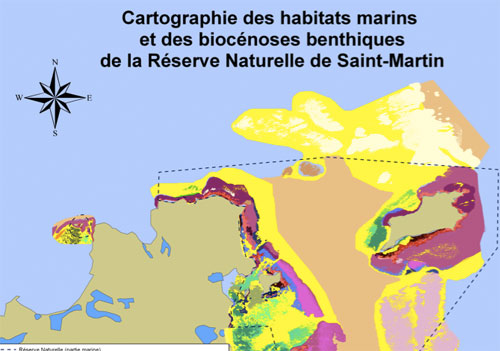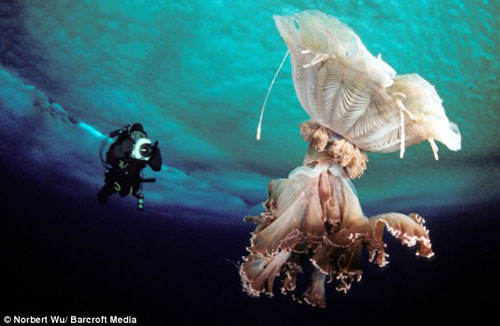On my way back from Bell Point, I stopped by the boat debris in the bay near our house. Hiding there was some sort of stonefish or toadfish, but due to a camera malfunction, I was not able to photograph it. I stopped by the house to switch cameras, but when I returned it was gone. I did, however find an octopus, a mantis shrimp and I was repeatedly circled by one of the large silver fish with blue and black accents, the name of which I don’t recall.
If you are walking shoeless on a rocky shore, you may find these tips useful:
- If you find a usable sandal, wear it. Under most conditions, having one protected foot gives you a great deal more flexibility to find comfortable spots to step with your bare foot.
- Also, if you are lucky, you may find another sandal.
- If you find two sandals for the same foot, try wearing the larger one on the wrong foot.
- Should you find a better sandal, trade up.
- Be careful walking too far with just one found sandal. If it breaks, you may have to walk back with none.
- When leaving the shoreline, stash sandals above the water line for future use.
Bell Point is the closest point on the island to Creole Rock. To get there, I swam past Grand Case Beach Club and walked down the shoreline to the point. Snorkeling the area past the beach club is quite a pleasure. There are rocky outcroppings that provide a nursery for small fishes, and a variety of small corals and sponges live there, too.
While traversing the shore to reach the point, I encountered a great deal of matter washed up on the shore, including shells, dead corals of various types and, of course, manmade trash. The area at the point was very pretty, although too rough to snorkel.
I found an excellent set of 25 maps prepared by the Réserve Naturelle Saint Martin. A PDF containing the maps is available on their web site: http://www.reservenaturelle-saint-martin.com. The maps show the various geological, archeological and biological zones of the island, along with many other key natural and man-made features. I anticipate these maps will be very useful as we plan future explorations, and perhaps we can help advance studies of the island by independently verifying their accuracy. The PDF (64 MB) of the maps is here.

When you spend 400 hours underwater in near-freezing temperatures, you just might get some amazing photos. Norbert Wu spent 12 years documenting the underwater life and habitats in Antarctica over the course of more than 1,000 dives.

Below you will find photos of Les Fruits de Mer expedition field headquarters. Located at the Flamboyant (of course), in the town of Grand Case, they serve as both our living quarters and our expedition staging area. Our telecommunications center is located outside near the bay, where we are able to access WiFi. Unfortunately, I need to cut this post short, as the telecommunications center is also frequented by mosquitos.
This morning I took a walk past the airport and up the little dirt road I had noticed a few days ago. The area was a mix of trees and meadows and many butterflies and other insects were around the road, probably enjoying some water from this morning’s rain.
One of my first discoveries was the plant on which the swallowtail caterpillars feed. Although I don’t know what it is called, I do know that the caterpillars prefer the young shoots in shady areas. These they will eat until not a bit of leaf is left, while larger shrubs in exposed areas are almost totally untouched.
I was also able to photograph a couple of the local butterflies, including a tiny yellow sulfur and a fuzzy little blue butterfly. There is also a tiny white butterfly with yellow forewings, cabbage butterflies, larger sulfurs, the buckeye-type butterfly, a skipper, some sort of fritillary, the monarch and the swallowtail. There is also some small black butterfly or moth that I have yet to get a good look at.
On the hill there were plenty of goats, a tree with little green fruits that almost look like olives and a strange, super-prickly cucumber-like vine. On my way back, I found a struggling swallowtail. At first I thought it might be a dying mother that just used her last energy to lay eggs, but seeing the brilliant colors and watching how it pumped its wings, I realized it must be a newly hatched adult still working up the strength to fly. I also saw hundreds of baby spiders hatching from an egg sack and almost ran head on into a paper wasp nest.
Today we did an Extreme Shallow Snorkeling mission on Ilet Pinel, a small island near the town of Cul de Sac. While waiting for the ferry, we saw an octopus…and a man washing it down with leaves and sea water. Once we arrived, we were accompanied by a dog on our walk across the island and found that the surf on that side was too rough for snorkeling.
Returning to the protected side, we found that a new eco-tour business, Wakawa now occupied the main snorkeling area. We chatted with the marine biologist staff there for a bit before snorkeling. They have high-tech snorkels that give guided underwater audio tours of the snorkel area. While snorkeling, we saw many needle-nosed fish (I’m not sure of the name) and one spotted eagle ray, but again I did not get a good photo of it.
After a delicious lunch at the Yellow Beach restaurant (finishing with some coconut delight) we rested briefly before snorkeling the very shallow waters off the nearby beach. As we often do, we found a sea hare, a slug-like creature that feeds on sea plants. I also found a brightly colored crab and a very small green moray eel. Although there were not a great deal of corals, there were many small, green Cnidaria on many of the rocks.
Overall, it was a beautiful day and a very successful mission. There were so many interesting small fishes in the shallow areas, I really must return soon with my proper camera for some macro photography.
Yesterday morning we went over to the Dutch side of the island to take a class with Fraser Purdon. He taught us how to troubleshoot, disassemble, service and reassemble R-series Scubapro regulators. We also learned how to do maintenance on BCDs.
The class was great, and it was really cool to see how simple and straightforward unbalanced piston regulators are on the inside. We learned not just how to open them up, but also why they are designed the way they are and how everything works together. I love the idea of being able to understand and maintain my own gear, particularly because underwater I am depending on it for my air supply.
For anyone who doesn’t know, the regulator is the piece of scuba equipment that takes the high pressure air in your tank and converts it to a pressure that is easy to breathe. Because divers experience different ambient pressure at different depths, the regulator provides air at the required pressure whether you are on the surface or 100 feet underwater.
On my afternoon walk, I headed out past the airport, through Hope Estate, an industrial-ish area, and a little past the turn off to Cul de Sac, towards Orleans. Inspecting every milkweed plant, I did find some chrysalides, but only ones that were either evacuated or eaten by some sort of predator or parasite.
In an abandoned, or seemingly abandoned yard of rock and dirt piles, I did get a chance to photograph some sort of fritillary and a goat. Outside a nursery (the kind that sells plants), I photographed a young lizard. Also pictured below are some sort of skipper (the small butterfly) and my third iguana sighting, this one not so fortunate.







































































